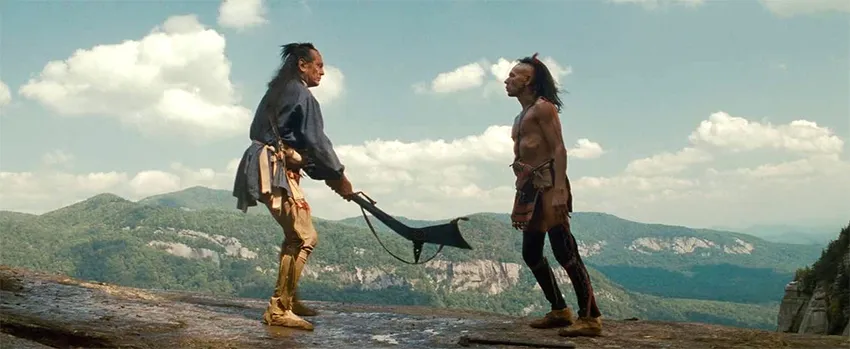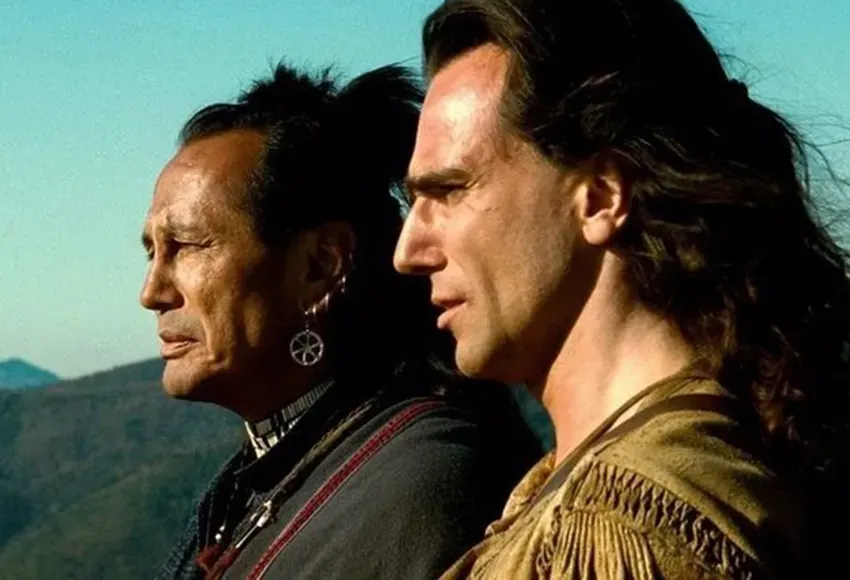The Last of the Mohicans: Heading back into the American wilderness with Hawkeye and Chingachgook
The first film I watched at Seattle's landmark Cinerama Theatre was Michael Mann's The Last of the Mohicans. I'd just arrived at the University of Washington, and as introductions to one of the great motion picture houses in the world go, this was a memorable one. Mann's adaptation of James Fenimore Cooper's 1826 novel – which owes more to director George B. Seitz's 1936 feature than it does to the source material – is a visually dynamic, larger-than-life romantic epic that has gloriously stood the test of time. Three decades after its original release, the film has become a bona fide classic.
Set during the height of the French and Indian War, the plot follows Mohican Chingachgook (Russell Means); his eldest, Uncas (Eric Schweig); and his adopted son, Hawkeye (Daniel Day-Lewis) as they make their way up the Hudson River. They stumble upon a Huron war party ambushing a British column heading to Fort William Henry, putting themselves in the middle of a fracas they'd have rather stayed out of.
The trio rescue Maj. Duncan Heyward (Steven Waddington) and sisters Cora (Madeleine Stowe) and Alice Munro (Jodhi May), the daughters of Fort William Henry's stern commander, Col. Edmund Munro (Maurice Roëves). Huron war chief Magua (West Studi) has sworn revenge against the colonel and his kin for an unspeakable wrong done to him and his family. He will stop at nothing to put all three under his knife, so Chingachgook, Uncas, and Hawkeye decide to protect Cora and Alice from harm no matter what the cost.
Mann has always been considered something of a visceral, aloof filmmaker. Masterworks like Thief, Manhunter, The Insider, Collateral, and Heat aren't particularly well known for their nuanced love stories, and female characters drift in and out of each in support of their male co-stars, frequently without any agency of their own. There are exceptions, of course, and actors like Joan Allen, Ashley Judd, Diane Venora, Jada Pinkett Smith, Gong Li, and Tuesday Weld all make significant impressions even if the films they are in keep them at arm's length.
This makes The Last of Mohicans a bit of an anomaly in Mann's filmography. While the focus is centered on Hawkeye, Cora is presented as nearly an equal (at least for the time period). There's a reason they are inextricably drawn to one another, and it's because they are kindred spirits who have similarly fiery personalities. They augment one another's strengths and smooth over their internal weaknesses. They mesh physically, intellectually, and spiritually, and even though the worlds they come from could not be more different, the purity of their union is undeniable from the first second they engage in confrontational conversation.
The other essential element is how Mann and co-writer Christopher Crowe make an attempt to play down the "white savior" aspects of Cooper's source material (as well as Seitz's emotionally stunted – if well shot – adaptation) and give more complexity to Chingachgook and Uncas. The latter gets his own love story with the younger Munro daughter, Alice, their affair all hushed glances across smoke-filled battlefields and brief embraces as they escape one danger only to land in the muck and mire of a new one.

But it is Chingachgook whom Mann rightfully puts in the spotlight during many of the picture's most critical sequences, most notably during the thrillingly gut-wrenching climax. The first national director of the American Indian Movement made his acting debut in the film, and his commanding presence is subtly dominating. The showdown atop a massive cliff between Chingachgook and Magua is an intense, tearfully heartbreaking act of rage-fueled heroism that's extraordinary.
There is a technical precision to all of this that's seldom seen anymore: Thousands of extras (including an estimated 900 Native Americans). Massive sets built to scale in the North Carolina wilderness. Costumes meticulously crafted to be as historically accurate as possible. Large-scale battle scenes, including the awesome siege of Fort William Henry. It's the type of filmmaking largesse that CGI trickery has all but made obsolete. Nothing has a digital sheen reminiscent of a video game. It's all practical, giving the film a tactile texture that's so naturalistically lived-in that a viewer could be forgiven if they felt the need to wipe the sweat away from their brow or dried-on mud off their arm while watching events unfold.
Yet, in the end, it is the human element that matters most, and that's exactly as it should be. The love story between Hawkeye and Cora is a sensuous spectacle of human entanglement that's lasting and pure. The tragedy fueling Magua's fury has grit and bite, making him a compelling villain whose everlasting pain has transformed him into a bloodthirsty monster worthy of our empathy but undeserving of forgiveness. A father's love leads to unimaginable feats of strength that border on superhuman. The inhumanity of war blurs the line between sanity and insanity, while making the ultimate sacrifice for love has disastrous consequences impossible to foresee.
But life goes on. Chingachgook gets the final word, his eyes having borne witness to a world in chaos, knowing that for all his people have lost, this is only the beginning of the volatile uncertainty still to come. Mann gives The Last of the Mohicans to him, and even as Hawkeye and Cora embrace, Chingachgook's observations remain chilling in their haunting majesty, unforgettable in their cathartic sadness, and prescient in their disquieting certainty.
Also, save the Cinerama. Don't let it disappear.
Now celebrating its 30th anniversary, The Last of the Mohicans is available on DVD and Blu-ray, and to purchase digitally on multiple platforms.


